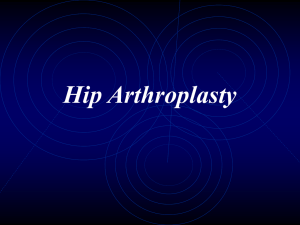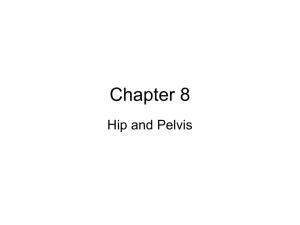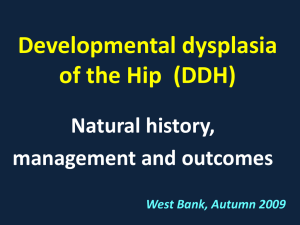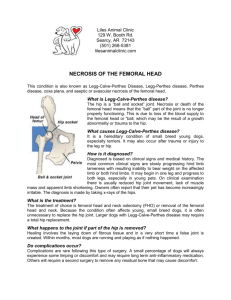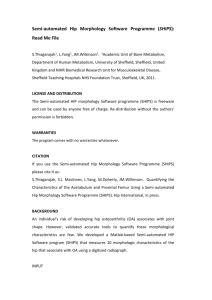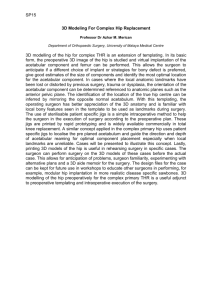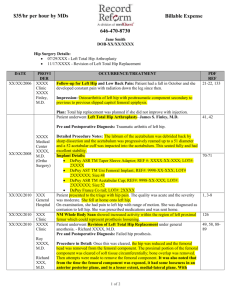Hilgenreiner's line
advertisement
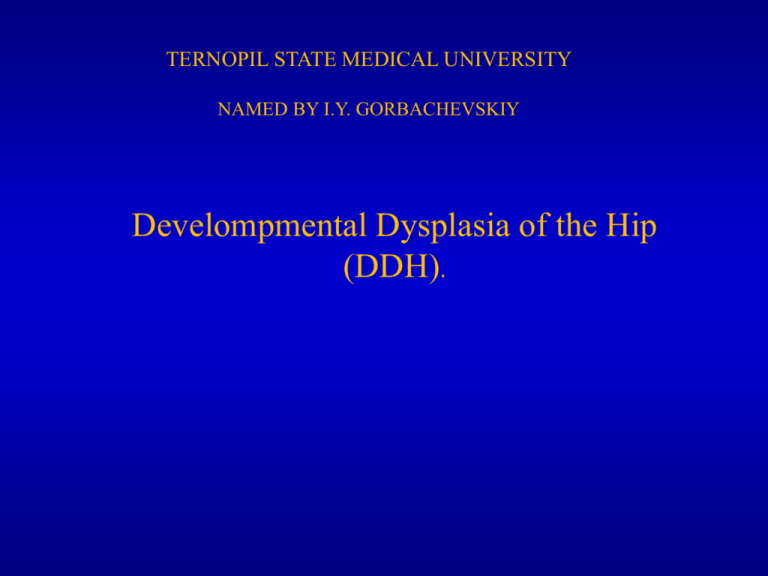
TERNOPIL STATE MEDICAL UNIVERSITY NAMED BY I.Y. GORBACHEVSKIY Develompmental Dysplasia of the Hip (DDH). Definition • Developmental dysplasia of hip is defined as partial or complete displacement of the femoral head from the acetabular cavity since birth. Definition Risk factors: Females First borns Familial Faulty intrauterine position Theories of Aetiology Genetic theory Dysplastic trait is found in families. Hormonal theory Hormone induced joint laxity. Mechanical theory Faulty intrauterine positions particularly in the first born. Primary acetabular dysplasia. Remember The incidences in DDH 1 per 1000 live birth. Left hip affected in 67% of cases. Family history present in 20%. 1:3 cases are bilateral. Female preponderance. Pathology The following pathological changes are observed in DDH and the severity varies according to the stages of the disease. Bone • Acetabulum There could be a primary acetabular dysplasia and the acetabulum is shallow. There could be a gap or groove at posterosuperior aspect. The triangular outer surface of ilium and acetabulum, are in the same line. Above the acetabulum, there is a depression containing the head of the femur. Bone • Head of femur The dislocated head of femur at first appears normal, ossification is delayed, later head is flat on its posterior and medial aspect. Femoral head when present in the ilium is buffer or conical shaped. Bone • Neck of femur There could be shortening and anteversion. • Pelvis The pelvis is usually tilted forwards, it is small and atrophied. There is lordosis and it may be more vertical than normal. Capsule The capsule could show hour glass constrictione, one containing head and the other containing head the acetabulum. Constriction is produced by iliopsoas and the ligamentum teres passes through this constriction and it is hypertrophied. Muscles • Pelvifemoral group Adductors, sartorius, gracilis, rectus femoris, hamstrings, tensor fascia lata muscles. These muscles are shortened and they prevent reduction of the head. • Pelvitrochanteric group (obturators, quadratus femoris, iliopsoas) These are elongated and the psoas forms an obstacle to reduction. • Gluteal muscles show little organic change but power is diminished. Stages of developmental dysplasia of hip: 1) dysplastic stage, 2) dislocatable or subluxation stage, 3) dislocation stage Clinical Features Infants Childhood and adolescents Adults Look for other anomalies. •If hip is dislocated all signs of dislocations present. •Thigh and gluteal folds asymmetric. •Perineum widened. •Abduction decreased by 50%. •Internal rotation increased. 1. Gait Waddling/sailors 2. Lordosis 3. Deformity Unilateral shortening of leg Bilateral leg shortening with perineum wide, buttocks broad and flat 4. Palpation vascular sign of Narath is positive 5. Movements Abduction and lateral rotation are decreased 6. Measurements Supratrochanteric shortening is present •All the signs seen in adolescents •Pain in the hip •All the features of osteoarthritis hip Clinical Features • • • • Galeazzi is sign positive. Ortolani's sign of entry is positive. Barlow's provocative test is positive. Delayed walking. Galeazzi is sign • The child is in supine position with both the hip and the knee in flexion. The level of both the knee joints are noted with reference to a horizontal line. This test is useful in assesing unilateral cases of DDH in children between 3 and 8 months. Galeazzi is sign Normally, both the knees should be at the same level. In DDH, the affected knee is seen beneath the horizontal line indicating femoral shortening. The shortening is in the supratrochanteric region and can be assessed by the Bryant's triangle. The Bryant's triangle Barlow´s Sign How to perform? This test is done within 2 to 3 days of birth. The infant is supine with the knees fully flexed and the hip at 900 of flexion. The hip is slowly abducted to 450 and the head is slowly pushed towards the acetabulum by the fingers. Barlow´s Sign This test is positive when the joint is dislocated and the femoral head returns to the acetabulum with a click or jerk. Reliable and useful up to 6 months after which the greater trochanter cannot be held with tip of the middle finger. Ortolani's sign • This test is done between 3 and 9 months and is not satisfactory in a newborn. Here, the infant is supine, with the hip and knee flexed. The hip is slowly adducted and abducted to detect any reduction of the femoral head into the acetabulum. Ortolani's sign This test indicates the reduction of the dislocated hip. These two tests are generally reliable and should be performed as a screening tests in all cases of suspected DDH. They are misleading if abduction is restricted due to adduction contractures. Skin fold test of gluteal region • Normally, the skin folds are symmetrical in nature. In DDH they are no longer symmetrical due to the shortening of the affected limb. Trendelenburg tests • The patient is made to stand first on the normal limb and then on the affected limb. The contralateral leg is then raised from the ground. • When standing on the normal limb, the opposite hip is in a higher position, but when the patient or the child stands on the affected limb, the opposite pelvis drops indicating impairment of abductor mechanism due to DDH. This test cannot be performed in infants. Radiographs of pelvis show in Infants • Radiographic examination in infants is of little value, but von Rosen's line is helpful in making an early radiological diagnosis in this age group. • This is a line which helps in the diagnosis of DDH radiologically in infants less than 6 months. It is an anteroposterior view of the pelvis taken with the lower limbs in full medial rotation and 45° abduction. Rosen's line • When the hip is normal, upward prolongation of the long axis of the shaft of the femur points towards the lateral margin of the acetabulum and crosses the pelvis in the region of the sacroiliac joint. When the hip is dislocated upward, prolongation of this line points towards anterior iliac spine and crosses the midline in the lower lumbar region. This line is not useful after 6 months. Standard anteroposterior views are preferred in a child older than 6 months. Ultrasonograms • Graf classification of infant hips based on the depth and shape of the acetabulum as seen on coronal ultrasonograms. Type I: normal; characterized by a well-formed acetabular cup with the femoral head beneath the acetabular roof. Type II: immature in infants less than three months of age and mildly dysplastic in infants older than three months; characterized by a shallow acetabulum with a rounded rim. Type III: subluxated; characterized by a very shallow acetabulum with some displacement of the femoral head. Type IV: dislocated; characterized by a flat acetabular cup and loss of contact with the femoral head. Clinical Features in Children and adolescents Here, the patient shows a waddling or sailor's gait. There is an increased lumbar lordosis. The deformity frequently encountered in unilateral cases is shortening. In bilateral cases, both the lower limbs are short, perineum is wide, buttocks are broad and flat. Femoral artery is prominently felt. Abduction and lateral rotation movements of the hip are decreased, Trendelenburg tests are positive. Clinical tests of importance in infants are not of relevance in this age group. Lumbar lordosis Radiographs of pelvis show Radiographs of pelvis show in Children and adolescents Unlike in infants, radiographs of pelvis show important features in this age group. The following radiological parameters should be noted. • Perkin's line This is a vertical line drawn at the outer border of the acetabulum Radiographs of pelvis show in Children and adolescents • Hilgenreiner's line This is a horizontal line drawn at the level of triradiate cartilage. Radiographs of pelvis show in Children and adolescents • Shenton's line This is a smooth curve formed by the inferior border of the neck of the femur with the superior margin of the obturator foramen. This line is broken in DDH. Radiographs of pelvis show in Children and adolescents • Acetabular index Normal value is less than or equal to 300. Radiographs of pelvis show in Children and adolescents • CE angle of Wiberg • The normal value is 15 to 30°. Radiographs of pelvis show in Children and adolescents Hilgenreiner's line • The Hilgenreiner's line and the Perkin's line help to assess the position of the femoral head. Normally, the head lies in the lower and inner quadrant formed by these two lines. In DDH, the head lies in the upper and outer quadrant Perkin's line Radiographs of pelvis show in Children and adolescents Shenton's line • The continuity of Shenton's line is broken in DDH. The acetabular index and the CF angle of Wiberg help to assess the acetabulum. Acetablar angle Right DDH in young adult. X-ray examination • • • • • H = a horizontal line drawn between the two triradiate cartilage centers of the hips defines a horizontal planne and an approximation to flexion axis of the hips. Hilgenreiner's Line P = a perpendicular line to the horizontal line drawn at the edge of the boney part of the socket (there's more in cartilage that can't be seen). Perkin's Line The center of the femoral head ought to be well within the lower inner quadrant of the drossing of those two lines. S = an oval that traces the lower pubis contour, ought to smoothly continue on to trace the lower edge of the neck of the femur. Shenton's Line. In this case, Shenton's line is off and discloses that the femur is migrating upward as these shallow hip sockets do not satisfactorily contain the ball in the sockets. U = uncovering. That's the amount of the femoral head that has no boney coverage. X-ray examination • DDH with residual acetabular dysplasia. Radiographs at birth, 3, 10 and 19 years (top to bottom) show persisting dysplasia. Remember •Ortolani's test (is a test of entry) relocates a dislocated hip. •Barlow's test (test of exit) dislocates a dislocatable hip. •Both these tests lose their significance after infancy. Clinical Features In adults • DDH in adults shows all the features seen in adolescents. In addition, patient will have features of secondary osteoarthritis of the hip namely pain, stiffness, limp, crepitus, restricted movements, etc. Treatment • The aim of treatment in DDH is to achieve and maintain an early concentric reduction to prevent future degenerative joint disease. Treatment In infants • Reduction can be obtained and maintained bv Pavlik harness which was first described by Arnold Pavlik, in the year 1958, von Rosen splints and other splints. Pavlik harness is the most important appliance useful in this age group. This is the onli harness that promotes spontaneous reduction of a dislocated hip and maintains the reduction, whereas other appliances only maintain the reduction. Hence, Pavlik harness is called as “dynamic flexion abduction orthoses". This is useful in children less than 6 months of age. Treatment In infants Apart from the reduction and the immobilisation, it allows active movements in all directions except extension and adduction. Nappies can be changed easily. The success rate of this harness is 85 to 95 per cent. However, as the age advances, soft tissue contractures develop along with secondary changes in the acetabulum, which bring down the success rate of Pavlik harness. Complications include osteonecrosis and failure of reduction. Treatment Between 6 and 18 months • As mentioned earlier, Pavlik harness has no role in the treatment of DDH in this age group. Here, the treatment of choice is gentle closed reduction and hip spica application. Open reduction is done if this method proves unsuccessful. Hip spica application • Nine months old girl in a hip spica after being diagnosed with DDH Treatment Between 18 and 36 months In this age group open reduction is the treatment of choice as closed reduction is often not successful. Open reduction is to be followed with either pelvic or femoral osteotomy to provide concentric reduction of the femoral head within the acetabulum. Role of osteotomies Osteotomies are done for instability, failure of acetabular development or progressive head subluxation after reduction. They are done only if congruent reduction is possible, if there is satisfactory range of movements and if the femoral head has a reasonable sphericity. The osteotomies could be femoral or pelvic and the choice is usually left to the surgeons, but there are some guiding principles. Pelvic osteotomies • are chosen if there is severe dysplasia and if radiographic changes are seen on the acetabular side. Femoral osteotomies • The varus derotational osteotomy places the top of the femur in varus and rotated backward but the rest of the leg is turned to a forward pointing posture - connecting the two with a metal plate. Femoral osteotomies • This is the procedure of choice if there are changes in the femoral head and if there is increase in anteversion of the neck. Treatment 8-18 years • In this age group, open reduction is followed by femoral shortening or pelvic osteotomies. If osteoarthritis of the hip develops, total hip replacement is the surgery of choice. Arthrodesis of the hip is rarely done. Thank you for attention

